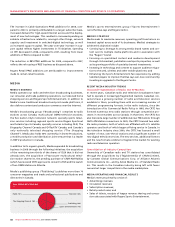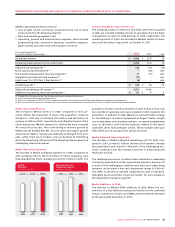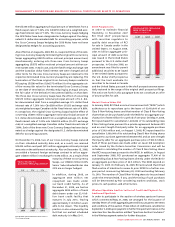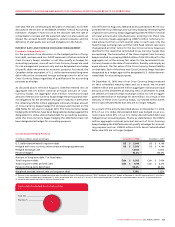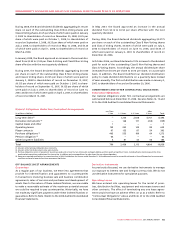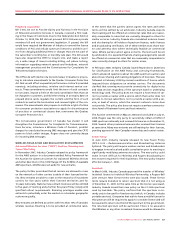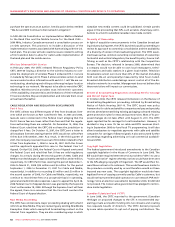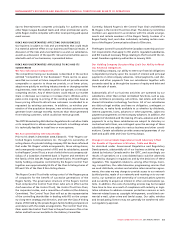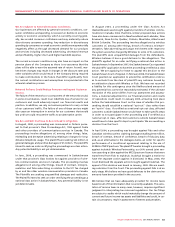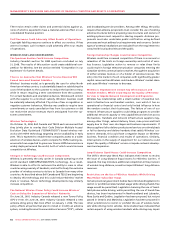Rogers 2008 Annual Report Download - page 61
Download and view the complete annual report
Please find page 61 of the 2008 Rogers annual report below. You can navigate through the pages in the report by either clicking on the pages listed below, or by using the keyword search tool below to find specific information within the annual report.
ROGERS COMMUNICATIONS INC. 2008 ANNUAL REPORT 57
MANAGEMENT’S DISCUSSION AND ANALYSIS OF FINANCIAL CONDITION AND RESULTS OF OPERATIONS
Proposed Legislation
Bill C-555, An Act to Provide Clarity and Fairness in the Provision
of Telecommunications Services in Canada, received a first read-
ing in the House of Commons. Due to the federal election held on
October 14, 2008, this Bill did not proceed. Bill C-555 was a private
members bill and not government legislation. If passed, the bill
would have required the Minister of Industry to amend the licence
conditions of PCS and cellular spectrum licences to prohibit carri-
ers from charging additional fees or charges that are not part of
the subscriber’s monthly fee or monthly rate plan. The bill would
have also required the CRTC to inquire into, and make a report
on, a wide range of issues including billing, cell phone locking,
information regarding network speeds and limitations, network
management practices and the Commissioner for Complaints for
Telecommunications Services.
The Office de la Protection du Consommateur in Quebec is propos-
ing to introduce amendments to the Quebec Consumer Protection
Act that would affect sequential performance contracts provided
remotely, including wireless, wireline and Internet service con-
tracts. These amendments would limit the term of such contracts
to two years, impose a limit on the early cancellation fees that can
be charged to customers, prohibit the setting of an expiry date on
prepaid phone cards, regulate the content and the form of such
contracts as well as the termination and renewal rights of the con-
sumers. The amendments also propose to institute a right of action
for consumer protection associations to apply for discontinuance
of practices or contractual clauses that contravene the Quebec
Consumer Protection Act.
The Conservative government of Canada has stated it will
strengthen the Commissioner for Complaints for Telecommunica-
tions Services, introduce a Wireless Code of Conduct, prohibit
charges for unsolicited incoming SMS messages and give the CRTC
power to block unfair charges. Rogers does not currently charge
for incoming SMS messages.
WIRELESS REGUL ATION AND REGULATORY DEVELOPMENTS
Advanced Wireless Services (“AWS”) Auction, Roaming and
Tower/Site Policy
In November 2007, Industry Canada released its policy framework
for the AWS auction in a document entitled Policy Framework for
the Auction for Spectrum Licences for Advanced Wireless Services
and other Spectrum in the 2 GHz Range. Of the 90 MHz of available
AWS spectrum, 40 MHz were set aside for new entrants.
The policy further prescribed that all carriers are allowed to roam
on the networks of other carriers outside of their licenced territo-
ries. New entrants are able to roam on the networks of incumbent
carriers for five years within their licenced territories and for
10 years nationally. National new entrant licencees will be entitled
to five years of roaming and a further five years if they comply with
specified rollout requirements. Roaming privileges enable new
entrants to potentially enter the market on a broader geographic
scale more quickly.
New entrants are defined as carriers with less than 10% of Canada’s
wireless revenue. Roaming is to be provided at commercial rates.
In the event that the parties cannot agree, the rates and other
terms will be settled by an arbitrator. Industry Canada expects
that roaming will be offered at commercial rates that are reason-
ably comparable to rates that are currently charged to others for
similar services. Industry Canada also mandated antenna tower
and site sharing for all holders of spectrum licences, radio licences
and broadcasting certificates. All of these entities must share tow-
ers and antenna sites where technically feasible at commercial
rates. Where parties cannot agree on terms, the terms will be set
by arbitration. It is expected that site-sharing arrangements would
be offered at commercial rates that are reasonably comparable to
rates currently charged to others for similar access.
In February 2008, Industry Canada issued Responses to Questions
for Clarification on the AWS Policy and Licencing Frameworks,
which answered questions about the AWS spectrum auction and
about tower sharing and roaming obligations of licencees. This was
followed in February 2008 by revised conditions of licence which
imposed those obligations on wireless carriers. The documents
clarified that roaming must provide connectivity for digital voice
and data services regardless of the spectrum band or underlying
technology used. The policy does not require a host network car-
rier to provide a roamer with a service which that carrier does not
provide to its own subscribers, nor to provide a roamer with a ser-
vice, or level of service, which the roamer’s network carrier does
not provide. The policy also does not require seamless communica-
tions hand-off between home and host networks.
The Auction commenced on May 27, 2008 and concluded on July 21,
2008. Rogers was the only party to successfully obtain 20 MHz of
AWS spectrum nationally and received its licences on December 22,
2008. Several other provisional winners also received their licences
at same time. Many new entrants are still waiting for their licences,
pending approval of their Canadian ownership and control review.
Tower Policy
In June 2007, Industry Canada released its new Tower Policy
(CPC-2-0-03 – Radiocommunication and Broadcasting Antenna
Systems). The policy will require wireless carriers and broadcasters
to engage in more local and public consultation prior to erecting or
significantly modifying antenna structures. The new policy could
make it more difficult for Wireless and Rogers Broadcasting to
erect towers required for their businesses. The new policy became
effective January 1, 2008.
Inukshuk
In March 2006, Industry Canada approved the transfer of Wireless’
Inukshuk licence to Inukshuk Wireless Partnership, a Rogers-Bell
joint venture. New licence terms were also issued. These licence
terms require Inukshuk to return spectrum that it is not using as
of December 31, 2009. At the same time as the licence was issued,
Industry Canada issued their new policy on the 2.5 GHz spectrum
used by Inukshuk. The policy confirms that the spectrum is cur-
rently only to be used for fixed services (which, in Canada, includes
portable services). Companies that wish to have a mobile licence for
this spectrum will be required to apply for a mobile licence and will
be required to return one-third of the spectrum to the government.
The returned spectrum will be auctioned. There is no assurance
that Wireless or any other incumbent licencee would be allowed to



